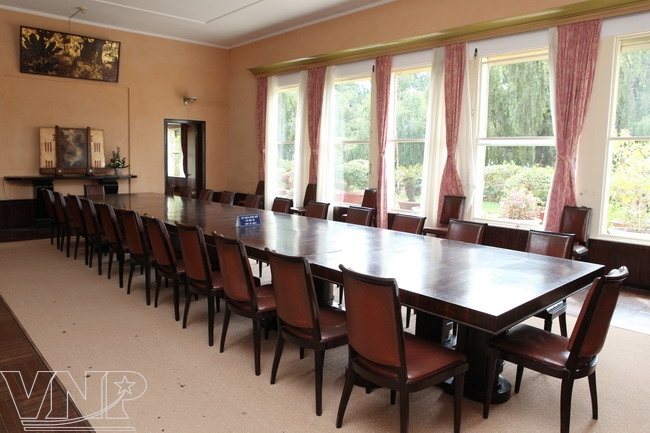 Bao Dai’s Palace is imbued with the European renovated architectural style.  A room of King Bao Dai for receiving guest.  A great pair of elephant’s tusks are hunted by himself.  Lobbies in Bao Dai’s Palace communicate with each other.  Queen Nam Phuong’s private room.  The showroom of images and belongings of King Bao Dai.  Bed room of Princess Phuong Lien and Prince Bao Thang. |
Bao Dai’s Palace was designed with 25 rooms with a system of well-disposed flat roofs. After entering the main gate is the great hall with eaves to shade the car park. The ground floor was used for parties and meetings with foreign guests and government officials. The palace also includes working rooms, King Bao Dai’s office, a library, rooms for entertainment and a large dining room. The working room was designed with small architectural miniatures to create a hamonious combination between the living space inside and nature outside through doors and steel framed windows. At present, in the reception room many precious objects of King Bao Dai are displayed, including a painting on Angkor Wat presented by Cambodian King Shihanouk, and three tiger skins and an elephant’s tusk hunted by himself.
The first floor of the palace was used as the private space of the royal family with bedrooms of King Bao Dai and his wife, Queen Nam Phuong, and their three daughters and two sons. Near the bedroom of the king stands a beautiful tower called Vong Nguyet (waiting for the moon). The bedroom of Prince Bao Long who was selected to ascend the throne was painted yellow and all decorations have the same colour.
 The garden on the grounds of the palace.  A tourist poses for a photo in royal dress.  Visitors are interested in a classic car placed outside the palace.  Foreign tourists record images inside the palace.  Bao Dai’s Palace attracts a large number of visitors. |
Outside, to the right of the main gate and in the back of the palace are small parks with a style often seen in French palaces. Around the palace are small paths shaded by pipe trees.
When visiting the palace, tourists will feel the solemn, close and warm space of the palace where imprints of a historical character, the last king of the feudal regime that existed for over thousands of years in Vietnam, are preserved.
Story: Nguyen Vu Thanh Dat – Photo: Le Minh



